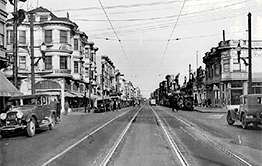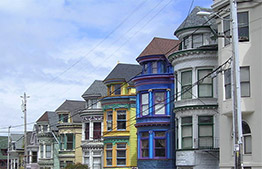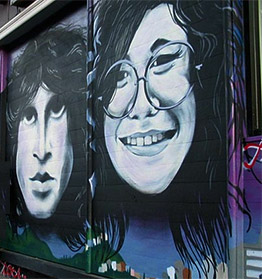
PART 2: THE HAIGHT AFTER THE QUAKE
After 1906, the Haight continued to expand with the influx of earthquake refugees rebuilding in what they perceived to be a safer neighborhood. By 1910 there were few large undeveloped parcels of land left in the neighborhood. The development that occurred after 1910 consisted largely of commercial structures on Haight or Stanyan Streets or three-story flats on the few empty lots located along subsidiary streets. One of the most interesting commercial structures built during this phase of the neighborhood's history was the Frederick Street Supermarket at 225 Frederick Street. This ornate commercial structure was designed by prominent San Francisco architect August Nordin in 1925.
With the start of the First World War, almost ninety percent of the Haight had been developed. The district had been transformed form a weekend resort into a full-fledged residential district with its own commercial district along Haight Street. The neighborhood had its own school (the Dudley Stone Grammar School on Haight, between Central and Masonic), a public library at 1835 Page, and at least four churches: St. Agnes, Hamilton Methodist Episcopal, All Saints Episcopal and the Second Church of Christ Scientist. Entertainment was not neglected either, with a nickelodeon at Haight and Cole and the Rice Institute of Dancing on Page, near Stanyan.
By the early 1920s the Haight was built-out, to use modern real estate parlance. Very few empty lots were available, and as a stable middle-class district, there was little impulse to demolish and build anew. One notable exception was the large 1920s-era apartment building located at 130 Frederick Street. The Haight was hit hard by the Depression, as was much of the rest of the city. Some residents lost their houses to the banks and others managed to hang on by deferring maintenance. Residents with enough money to spare left the declining and "crowded" neighborhood for greener pastures such as Forest Hills or St. Francis Wood. As the ornate gingerbread confections of the Victorian era began to age, homeowners frequently turned to stucco as their savior. Many houses in the Haight were unsympathetically remodeled in this fashion. By 1939, absentee landlords owned most of the dwellings in the Haight and fifteen percent were determined to be substandard by the Planning Department.
World War II proved even less kind to the Haight, with most of the large single-family dwellings carved up into a warren of apartments to house war workers. Others were converted into boarding houses. The end result was that the number of dwelling units in the Haight nearly doubled from 4,750 to 8,770 between 1939 and 1945. By the 1950s, the Haight was a neighborhood in decline. Deferred maintenance was taking its toll and the exodus of middle-class residents to newer suburbs to the south and west continued. Few new structures were constructed aside from a few "dingbats," large stucco apartments buildings constructed on under utilized parcels during the 1950s.
Low rents, combined with the neighborhood's legacy of outdated yet oddly appealing Edwardian architecture, attracted an increasing number of beatniks during the 1950s and hippies during the 1960s. The first store to open that catered to the new residents of the Haight was the Psychedelic Shop at 1535 Haight, near the intersection with Ashbury. Soon other businesses opened to cater to what was becoming a bona fide counterculture, including Mnasidika and In Gear (clothing stores), I/Thou (coffee shop). Far Fetched Foods (health food store), and many others. By the late 1960s, the Haight had its own radio station (KDIG) at 1775 Haight and its own band, the Grateful Dead, whose headquarters were at 710 Ashbury. After the Summer of Love, the Hippie Movement began to implode as a result of the increasing use of heavy drugs and growing disillusionment. The Haight became more blighted during the 1970s, not resurfacing until the 1980s, when the counterculture mystique became a selling point for home buyers.
In recent years, the Haight has become something of a tourist attraction, taking its place next to the other well-known San Francisco neighborhoods such as Chinatown, Nob Hill, and North Beach. Somewhat paradoxically, tourists seem to "discover" places anew, although history has already recorded their earlier significance. One might argue that this is the case with the Haight. Gone are the middle-class strivers, the World War II workers, and the hippies. Nonetheless, the Haight survives as a mixed-use residential district with a thriving commercial district that attracts visitors from all over the world seeking the increasingly distant flavor of the Summer of Love.




Top to bottom: Haight Street in the 20's; along Ashbury Street, 225 Frederick St.; Haight St. mural detail